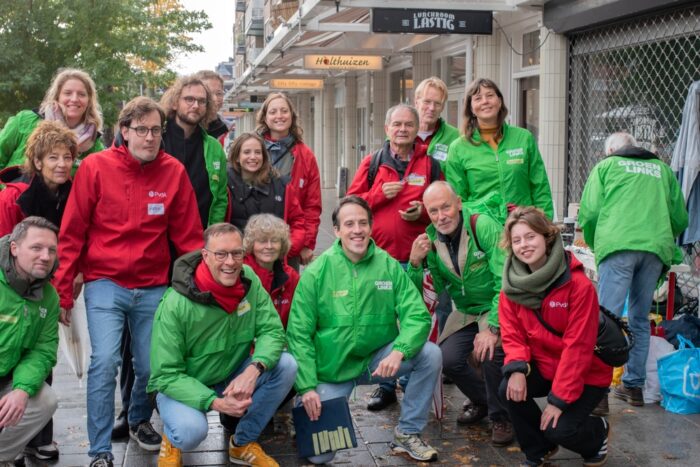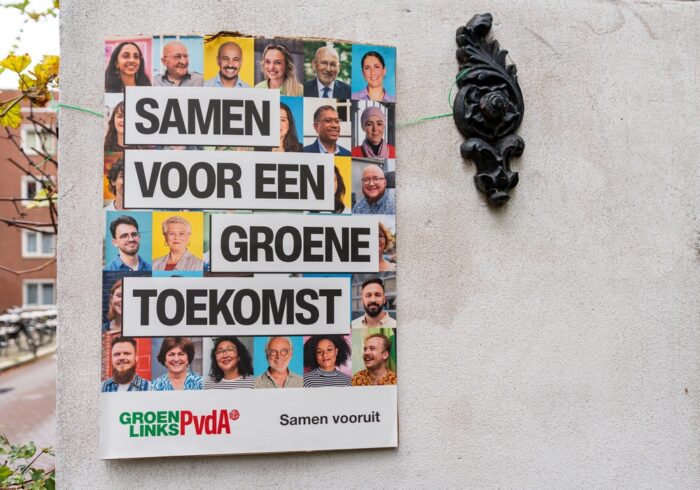Find all related Progressive Post
Progressive Post

Exit polls show that about 70 per cent of those who voted for BSP-UNITED LEFT in the current elections voted for BSP FOR BULGARIA in the previous parliamentary elections. This means that about 120-130,000 people who voted for the left-wing coalition in June 2024 have done so again now. And also that the number of left-wing voters who ‘boycotted’ the BSP in the current elections equals about 20-30,000.
At the same time, the data show that the new left coalition has received a surge of 50-60,000 new votes. Sociological data show that 15,000 of them come from the Left. That is how many voted for the Left in the previous parliamentary elections. There is no tide of votes from the political party ‘Solidary Bulgaria’ to BSP-UNITED LEFT. Such an electoral movement is an exception for BSP. Data from previous elections show that BSP relies almost entirely on those who voted for it in previous elections. The current surge of votes is due to voters who used to vote for the BSP but have abandoned it in recent years.
Electoral movement is also observed in Revival and ITN. Around 70 per cent of those who voted for both formations voted for them in the parliamentary elections in June. This probably represents the so-called ‘hard’ electorate. In the case of Revival it is about 200,000 voters (with about 300,000 votes for them nationwide) and in the case of ITN it is about 100-110,000 voters (with about 155,000 votes for them nationwide). The data does not show a tide of votes in any particular direction. The political party MECH (Morality, Unity, Honour) almost doubled its result – from about 64,000 to about 111,000votes. The largest vote surge was from three directions. Around 15,000 people who did not vote in the last election or voted ‘I don’t support anyone’ have now voted for MECH. They have picked up about 10,000 votes each from Revival and PP-DB. GERB and PP-DB registered a higher share of solid core. Around 80-85 per cent of those who voted for them now have voted for them in the previous election.
The case of the DPS-New Beginning and the APS is more peculiar. It has to do with their split in the DPS. The electorate of the DPS has split fairly evenly between the two formations (probably with a slight predominance of DPS-New Beginning). The two parties are almost equally represented among the Bulgarian Turks. However, DPS-New Beginning has a stronger representation outside this ethnic group, which explains its stronger performance in the elections. The data shows that about 70 per cent of all those who voted for the APS are Bulgarian Turks. In the case of the DPS-New Beginning this share is around 45-50 per cent.
Age distribution
Two age groups make up the smallest part of the active electorate: the youngest (18-29) and the oldest (over 70). Overall, about 25 per cent of all voters fall into one of the two categories (about 12-13 per cent in each). Each of the other four categories monitored by sociologists (30-39, 40-49, 50-59, and 60-69 accounts for between 17 per cent and 20 per cent of the electorate. In absolute terms: the youngest and the oldest constitute around 300-330,000 people. Each of the other age groups contains between 450 and 520,000 voters.
GERB (Citizens for European Development of Bulgaria) is the first political force in all age groups. Their strongest result is among those aged between 40 and 59 (around 28 per cent). it is among the youngest (23 per cent), but it’s still significantly higher in comparison with the second political force, PP-DB (We Continue the Change-Democratic Bulgaria), which in this age group has 16 per cent. In the case of PP-DB there is no significant dynamic by age: around 13 per cent and 16 per cent in all age groups. This is similar for APS (Alliance for Rights and Freedoms), between 6.5 per cent and 9 per cent. The political party Revival has the lowest vote among the youngest and oldest (around 9-10 per cent). In other groups, their result is close to the party’s average. The most significant difference in the result by age is observed in BSP-UNITED LEFT (Bulgarian Socialist Party). In the first four age groups (up to 59), BSP has a result between 3 and5 per cent. In the two oldest age groups, BSP is the second strongest party – 13 per cent in the 60-69 group and 23 per cent in the 70+ group. About 2/3 of those who voted for BSP were over 60 (or about 115 thousand people. DPS-New Beginning (Movement for Rights and Freedoms) has the highest result among the youngest (13-14 per cent) and the lowest among the oldest (6.3 per cent). The political party ITN (There Is Such a People) has weaker levels of support among the voters over 60. They have between 7 per cent and 9 per cent in the under 60 age groups and around 4-5 per cent in those over 60.
Educational cut
For most political parties, there is no significant difference in education. There are three significant exceptions to this list: PP-DB, DPS-New Beginning and APS. PP-DB has a higher score among those with university or even higher education – around 20 per cent, which is above the coalition average (14 per cent). The ratio of university graduates to people with secondary education of those who voted for PP-DB was 2:1. For most political parties it is almost 1:1. This concerns the electoral profile of those who voted for PP-DB. For university graduates, GERB is the first political force. In the case of the DPS-New Beginning and APS, the proportions are reversed. About 60 per cent of those who voted for them have secondary education and about 20-25 per cent with less than secondary education. This is because these parties rely on the support of minority groups that have a lower educational status: the Turks and the Romani.
Territorial
PP-DB, DPS-New Beginning and APS appear to be exceptions to the general picture when looking at the territorial voting pattern. PP-DB received almost 130 thousand votes in Sofia. This means that almost 40 per cent of their voters are from Sofia. At the opposite pole are again the DPS-New Beginning and APS. Around 55 per cent of their votes come from the villages and countryside (almost evenly distributed). If we look at the results in the districts and cities, we see that the votes for the individual political parties are close to their national results (except for DPS-New Beginning and APS).
Photo credits: Shutterstock/SilviyaStoyanova
| Cookie | Duration | Description |
|---|---|---|
| cookielawinfo-checkbox-advertisement | 1 year | Set by the GDPR Cookie Consent plugin, this cookie is used to record the user consent for the cookies in the "Advertisement" category . |
| cookielawinfo-checkbox-analytics | 11 months | This cookie is set by GDPR Cookie Consent plugin. The cookie is used to store the user consent for the cookies in the category "Analytics". |
| cookielawinfo-checkbox-functional | 11 months | The cookie is set by GDPR cookie consent to record the user consent for the cookies in the category "Functional". |
| cookielawinfo-checkbox-necessary | 11 months | This cookie is set by GDPR Cookie Consent plugin. The cookies is used to store the user consent for the cookies in the category "Necessary". |
| cookielawinfo-checkbox-others | 11 months | This cookie is set by GDPR Cookie Consent plugin. The cookie is used to store the user consent for the cookies in the category "Other. |
| cookielawinfo-checkbox-performance | 11 months | This cookie is set by GDPR Cookie Consent plugin. The cookie is used to store the user consent for the cookies in the category "Performance". |
| csrftoken | past | This cookie is associated with Django web development platform for python. Used to help protect the website against Cross-Site Request Forgery attacks |
| JSESSIONID | session | The JSESSIONID cookie is used by New Relic to store a session identifier so that New Relic can monitor session counts for an application. |
| viewed_cookie_policy | 11 months | The cookie is set by the GDPR Cookie Consent plugin and is used to store whether or not user has consented to the use of cookies. It does not store any personal data. |
| Cookie | Duration | Description |
|---|---|---|
| __cf_bm | 30 minutes | This cookie, set by Cloudflare, is used to support Cloudflare Bot Management. |
| S | 1 hour | Used by Yahoo to provide ads, content or analytics. |
| sp_landing | 1 day | The sp_landing is set by Spotify to implement audio content from Spotify on the website and also registers information on user interaction related to the audio content. |
| sp_t | 1 year | The sp_t cookie is set by Spotify to implement audio content from Spotify on the website and also registers information on user interaction related to the audio content. |
| Cookie | Duration | Description |
|---|---|---|
| CONSENT | 2 years | YouTube sets this cookie via embedded youtube-videos and registers anonymous statistical data. |
| iutk | session | This cookie is used by Issuu analytic system to gather information regarding visitor activity on Issuu products. |
| s_vi | 2 years | An Adobe Analytics cookie that uses a unique visitor ID time/date stamp to identify a unique vistor to the website. |
| Cookie | Duration | Description |
|---|---|---|
| NID | 6 months | NID cookie, set by Google, is used for advertising purposes; to limit the number of times the user sees an ad, to mute unwanted ads, and to measure the effectiveness of ads. |
| VISITOR_INFO1_LIVE | 5 months 27 days | A cookie set by YouTube to measure bandwidth that determines whether the user gets the new or old player interface. |
| YSC | session | YSC cookie is set by Youtube and is used to track the views of embedded videos on Youtube pages. |
| yt-remote-connected-devices | never | YouTube sets this cookie to store the video preferences of the user using embedded YouTube video. |
| yt-remote-device-id | never | YouTube sets this cookie to store the video preferences of the user using embedded YouTube video. |
| yt.innertube::nextId | never | This cookie, set by YouTube, registers a unique ID to store data on what videos from YouTube the user has seen. |
| yt.innertube::requests | never | This cookie, set by YouTube, registers a unique ID to store data on what videos from YouTube the user has seen. |
| Cookie | Duration | Description |
|---|---|---|
| COMPASS | 1 hour | No description |
| ed3e2e5e5460c5b72cba896c22a5ff98 | session | No description available. |
| loglevel | never | No description available. |


